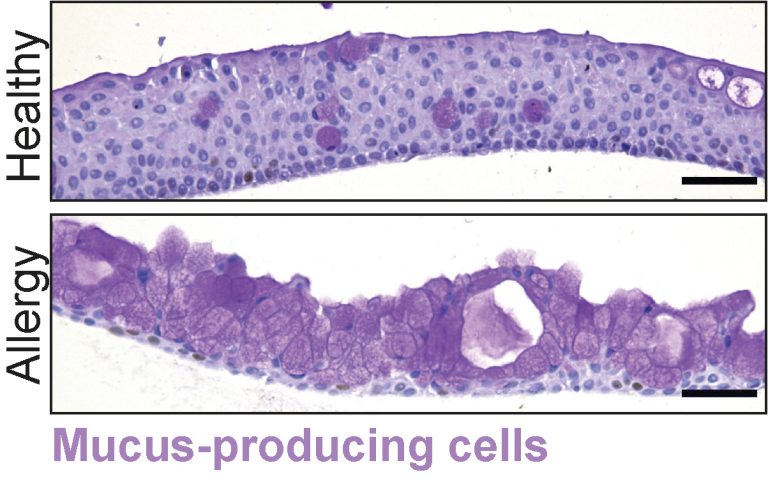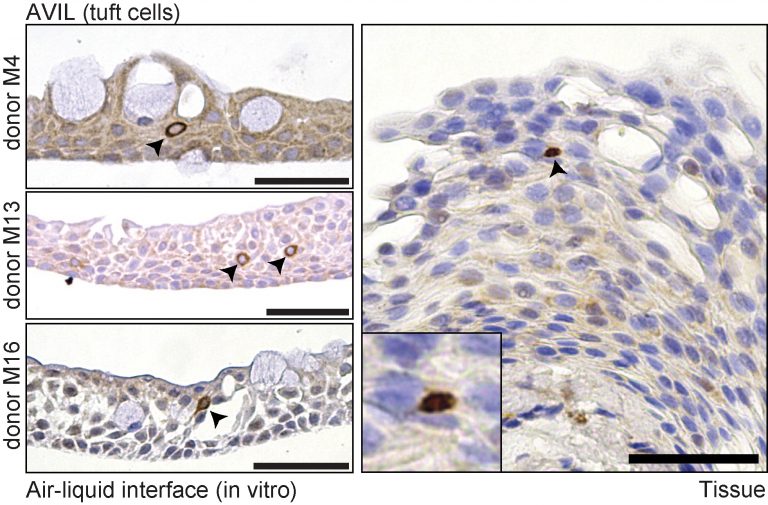Producing tears in a dish: researchers develop first model of human conjunctiva
The Organoid group produced the first organoid model of the human conjunctiva. These organoids mimic the function of the actual human conjunctiva, a tissue involved in tear production. Using their new model, the researchers discovered a new cell type in this tissue: tuft cells. The tuft cells become more abundant under allergy-like conditions and are therefore likely to play a role in allergies. The organoid model can now be used to test drugs for several diseases affecting the conjunctiva. The study was published in Cell Stem Cell on 11 January 2024.
Our eyes produce tears to protect themselves from injuries and infections. The conjunctiva, a tissue that covers the white of the eye and the inside of the eyelids, is partially responsible for the production of these tears. It participates in tear production through the release of mucus. This mucus allows the tears to stick to the ocular surface and protects it from pathogens.
Limited treatment options
Several diseases and disorders affect the conjunctiva, such as dry eye disease, cancer, allergies and infections. In severe cases, dysfunction of this tissue can lead to blindness. Until now, there has not been a good model of the human conjunctiva, which limits research into its function in sickness and in health. Consequently, there are limited treatment options for diseases affecting the conjunctiva.
First model
To gain more insight into the composition and functioning of the conjunctiva, the Organoid group set out to develop the first human model of this type of tissue. They used cells from an actual human conjunctiva and grew them into 3D structures in a dish. These miniature structures are called organoids and function as real human conjunctiva. “Once we had these functioning organoids, we wanted to know how the conjunctiva is involved in the production of tears,” Marie Bannier-Hélaouët, lead researcher in the project, explains. “We discovered that the conjunctiva makes antimicrobial components and therefore contributes to tear production in more ways than by simply making mucus.”
Allergies
The researchers then altered the conditions in the dish with the miniature conjunctivae to mimic allergies. “The organoids started to produce completely different tears: there was more mucus but there were also more antimicrobial components,” says Bannier-Hélaouët. Under these conditions, they also found a new cell type in the organoids: tuft cells. Bannier-Hélaouët continues: “Similar cells have been discovered in other tissues, but not in the human conjunctiva.” The tuft cells became more abundant under the allergy-like conditions, suggesting they play a role in the eye’s reaction to allergies.

Under allergy-like conditions, the number of mucus-producing cells increases. Credit: Marie Bannier-Hélaouët, copyright: Hubrecht Institute.
Drugs
The newly developed organoid model opens the door for research into diseases affecting the conjunctiva. “We can use our model to test drugs for allergies or dry eye disease, for example,” says Bannier-Hélaouët. In the long term, it may even be possible to make replacement conjunctivae for people with ocular burns, ocular cancers or maybe even genetic disorders. “In collaboration with Mor Dickman and Vanessa LaPointe at MUMC+/UM in Maastricht, we are now running preclinical studies in rabbits to assess whether this approach is feasible and helpful,” Bannier-Hélaouët concludes.

Tuft cells are visualized with the special marker Advillin (AVIL). Credit: Marie Bannier-Hélaouët, copyright: Hubrecht Institute.
Towards a clinical application
“There is a need for cell therapies to treat inflammatory diseases and cancers of the conjunctiva, which often lead to blindness,” notes Mor Dickman, ophthalmologist and expert in corneal and stem cell transplantation. “Our preliminary findings from transplanting organoids in rabbits suggest that organoids are a promising therapeutic strategy. We are excited by the prospect of bringing this therapy to the clinic in collaboration with Prof Hans Clevers and the Organoid Group,” share Mor Dickman and Vanessa LaPointe from the MERLN Institute for Technology-Inspired Regenerative Medicine in Maastricht.
Publication
Human Conjunctiva Organoids to Study Ocular Surface Homeostasis and Disease. Marie Bannier-Hélaouët, Jeroen Korving, Ziliang Ma, Harry Begthel, Amir Giladi, Mart M. Lamers, Willine J. van de Wetering, Nobuyo Yawata, Makoto Yawata, Vanessa L. S. LaPointe, Mor M. Dickman, Rachel Kalmann, Saskia M. Imhoff, Johan H. van Es, Carmen López-Iglesias, Peter J. Peters, Bart L. Haagmans, Wei Wu and Hans Clevers. Cell Stem Cell, 2024.
Source: Hubrecht Institute








